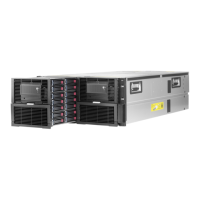Understanding the effects of a hard drive failure
If a hard drive fails, all logical drives that are in the same array are affected. Each logical drive
in an array may be using a different fault tolerance method, so each logical drive can be affected
differently.
• RAID 0 configurations cannot tolerate a drive failure. If any physical drive in the array fails,
all non-fault-tolerant (RAID 0) logical drives in the same array will also fail.
• RAID 1+0 configurations can tolerate multiple drive failures as long as no failed drives are
mirrored to one another (with no spares assigned).
• RAID 5 configurations can tolerate one drive failure (with no spares assigned).
• RAID 6 with ADG configurations can tolerate simultaneous failure of two drives (with no
spares assigned).
Identifying a compromised fault tolerance
CAUTION: If fault tolerance is compromised, data loss can occur. However, it may be possible
to recover the data. For more information, see “Recovering from compromised fault tolerance”
(page 46).
If more drives fail than the fault-tolerance method can manage, fault tolerance is compromised,
and the logical drive fails. If this failure occurs, the operating system rejects all requests and
indicates unrecoverable errors.
For example, fault tolerance might occur when a drive in an array fails while another drive in the
array is being rebuilt.
Compromised fault tolerance can also be caused by problems unrelated to drives. In such cases,
replacing the physical drives is not required.
Recovering from compromised fault tolerance
If fault tolerance is compromised, inserting replacement drives does not improve the condition
of the logical volume. Perform the following procedure to recover data:
1. Check for loose, dirty, broken, or bent cabling and connectors on all devices.
2. Power down the D6020 (see “Powering down” (page 18)).
3. Power up the D6020 (see “Powering up” (page 18)).
In some cases, a marginal drive is operational long enough to allow backup of important
files.
4. Make copies of important data, if possible.
5. Replace any failed drives.
Factors to consider before replacing hard drives
You can replace hard drives without powering down the system. However, before replacing a
degraded drive:
• Open HPE SIM and inspect the Error Counter window for each physical drive in the same
array to confirm that no other drives have any errors. (For details, refer to the HPE SIM
documentation on the Management CD.)
• Be sure that the array has a current, valid backup.
• Use replacement drives that have a capacity at least as great as that of the smallest drive
in the array. The controller immediately fails drives that have insufficient capacity.
46 Troubleshooting the system

